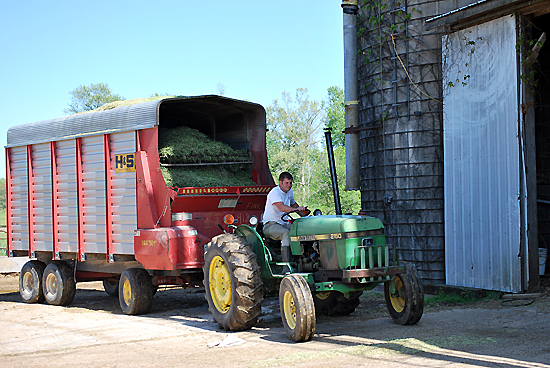Warm weather leads to exceptionally early silage harvest
Warm weather leads to exceptionally early silage harvest

Like most producers, Adair County dairy farmer Jonathan Gaskins regularly checks the progress of his forage crops, but he found a big surprise when checking his wheat fields early this spring.
“We were thinking we had two or three more weeks. But we came out here and checked it, and it was ready to harvest,” he said.
Gaskins began harvesting 110 acres of wheat April 3 and finished April 11. Normally wheat is harvested for silage during the last week of April or the first week of May.
Wheat is used for silage to feed lactating dairy cattle. Silage is a high quality feed that can increase milk production. To get the best quality silage, it’s important to harvest the crop when it reaches late boot stage, but it’s a really short window between when the crop reaches that stage and when it begins to head.
In mid-March, Gaskins saw the crop was maturing quickly and called Nick Roy, Adair County’s agriculture and natural resources agent with the University of Kentucky Cooperative Extension Service, to check his crop. Gaskins wasn’t the first dairy farm that Roy had checked for silage progress.
“The crop is at least three, if not four, weeks of ahead of schedule,” Roy said. “An unseasonably warm March led to early crop development. Everything across the state is ahead of schedule, and it doesn’t matter if you’re talking about the wheat crop or fruit trees.”
March 2012 was the warmest March in Kentucky since records were first kept 115 years ago. Average temperatures were 11 degrees above normal, said Tom Priddy, meteorologist in the UK College of Agriculture.
Harvesting this early may not necessarily be a bad thing for producers.
“This year, it has definitely helped, because I’m going to mix it in with my ration and save some of my corn silage,” Gaskins said.
“It could wind up being a tremendous benefit for farmers,” Roy said. “We’ve had nice weather the last few weeks without any rain to slow farmers down. Harvesting this crop earlier than normal is also going to allow farmers to get their corn silage crop out earlier than usual which may provide better yields for corn silage.”
Extension Weather

